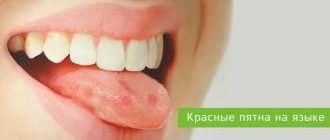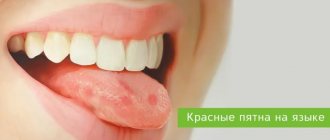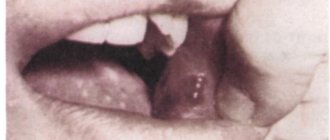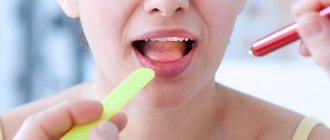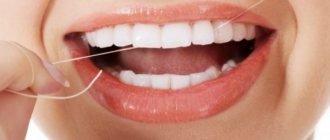White coating on the tongue is usually perceived as a symptom of the disease. A person, as a rule, does not consider his language. In order for us to stand in front of the mirror, stick out our tongue and begin to look at it, there must be some reason that prompted us to do so - discomfort in the throat or oral cavity or some other dissatisfaction with our health. And then we discover a white coating on the tongue (or, as they sometimes say, that our tongue is coated ). However, don't be scared right away. Even a healthy person can have a white coating on the tongue. On the other hand, plaque on the tongue can indeed be a manifestation of the disease. Therefore, it is useful to know how pathological plaque on the tongue differs from plaque, which is considered a variant of the physiological norm.
Physiological white coating on the tongue
White coating on the tongue is most often found in the morning. At night, less saliva is produced, which contributes to the activation of bacterial activity. As a result, by morning, almost all people develop a white coating on their tongue. Sometimes it is accompanied by bad breath.
As a rule, such plaque is easily removed during morning oral hygiene. When we brush our teeth, it is advisable to also brush our tongue, especially its root. Modern toothbrushes have a surface specially modified for this purpose (the other side in relation to the bristles).
However, the white coating disappears on its own as the day begins. It is erased when eating, and the greater amount of saliva released prevents it from forming again.
Reasons for appearance
Why does white plaque appear? The main reason lies in food debris that gets stuck between the lingual papillae. As a result, a favorable environment is created for the proliferation of bacteria. Most of these microorganisms die, but do not disappear without a trace. When in contact with saliva and epithelial particles, they stick to the tongue, forming a plaque. In this case, this plaque is partially removed by salivation. The film usually remains in hard-to-reach places, for example, at the root of the tongue. If it is not cleaned in time, it begins to spread to other areas, gradually covering the entire tongue. Considering that these are the remains of bacteria, the likelihood of developing dental diseases increases sharply.
Pathological plaque on the tongue
If the white coating on the tongue is caused by an illness, it persists throughout the day. A thin white coating occurs with any ARVI. It disappears as soon as the patient recovers.
Particular attention should be paid to the compaction of plaque. The body of the tongue is not visible through the thick coating. Such plaque is difficult to remove. Thick plaque is considered a sign indicating the severity of the disease.
The color of the coating on the tongue is also important. The more intense the color, the more serious the pathology that caused the plaque. The color of plaque is not only white. A yellowish tint to the plaque may be associated with a malfunction of the gallbladder or pancreas. Gray plaque is possible in case of stomach disease - gastritis, peptic ulcer. In some severe infectious diseases, plaque may acquire a black, bluish or greenish tint.
However, it should be taken into account that the color of plaque can be affected by smoking, drinking and eating.
What can cause pathological plaque?
The main reason is a malfunction of the internal organs. However, there are two other possibilities: smoking and improper oral hygiene. For active smokers, a yellowish coating is a constant companion, which may not indicate anything bad about health other than the presence of a bad habit. If you don't brush your mouth properly, your tongue will be completely ignored. It is wrong to brush your teeth alone. Bacteria accumulate on the surface of the tongue; they also need to be removed. To clean the tongue, many toothbrush manufacturers make a special brush on the other side. There are also scrapers for the surface of the tongue.
If a person does not smoke and maintains proper hygiene, but there is still plaque, then this may be an indicator of the following diseases:
- Diseases of the digestive system (the most common cause) are ulcers, gastritis, diseases of the gallbladder, pancreas, and liver. Usually in such cases the plaque is accompanied by a persistent unpleasant odor that does not go away even after cleaning.
- Diseases of the respiratory system - tuberculosis, bronchitis, asthma.
- Infectious diseases - influenza, sore throat, ARVI, acute respiratory infections.
- Reduced immunity.
- Diseases of teeth and gums.
- Changes in acid-base balance due to medications.
Diseases that cause plaque on the tongue:
- stomatitis;
- thrush (candidiasis). Caused by fungi of the genus Candida. The disease can be caused by long-term use of antibiotics or decreased immunity. With oral candidiasis, a typical manifestation is a dense milky-white coating that covers the tongue in spots. Similar spots may also appear on the roof of the mouth or gums. In severe cases, plaque covers the entire tongue as well as the walls of the throat, making swallowing and breathing difficult.
- scarlet fever. In the first days of the disease, the tongue is covered with a white-gray coating. Then the coating disappears, and the tongue acquires a crimson color;
- whooping cough. A pale yellowish coating on the tongue may be accompanied by bad breath;
- dysentery. A thick white coating is typical;
- cholera. Characterized by a dark coating (even black);
- diphtheria;
- gastritis;
- stomach ulcer;
- enterocolitis;
- pancreatitis;
- stomach cancer;
- kidney diseases;
- some other diseases.
How to properly clean your tongue with a toothbrush
How to properly clean plaque from your tongue using a toothbrush? To do this, it is enough to follow the following rules:
- Cleaning is performed after basic hygiene procedures: brushing the teeth and rinsing the mouth;
- Plaque is removed with progressive movements: the brush goes in one direction, first from the root to the tip of the tongue;
- Then the brush moves in the transverse direction, and then in the return direction: from tip to root;
- 4-6 movements are made in each direction;
- After this, the inner surface of the cheeks is carefully processed,
- At the final stage, rinse with an antibacterial solution.
When and which doctor to contact about a coating on the tongue
As a rule, tongue coating is not the main symptom.
And it is other symptoms that tell you which doctor you should see. If plaque on the tongue is accompanied by symptoms of ARVI, you should consult a physician. If you have symptoms of gastrointestinal diseases, contact a gastroenterologist. If there are no such symptoms, and the cause of your concern is plaque, in case of white plaque you can consult a dentist, in case of yellowish or gray plaque, you can consult a gastroenterologist. And in any case, you can consult a general practitioner - family doctor or therapist. A child with a persistent coating on the tongue should be shown to a pediatrician.
How to remove plaque from the tongue at home
How and with what to clean the tongue of an adult? There are several ways to quickly deal with this problem. Let's look at each of them in more detail.
Scrapers
These are special loop-shaped devices made of hygienic plastic. Scrapers effectively remove plaque without causing discomfort or gag reflexes. The tool must be moved from the base of the tongue to the tip until the film disappears. After this, the mouth can be rinsed with an antibacterial solution.
Toothbrushes
Most models have special pads on the back surface or removable attachments for removing plaque. Hygienic procedures are carried out according to the scheme discussed above. To enhance the effect, you can apply a small amount of toothpaste to the surface of the nozzle.
Irrigators
These are modern devices for comprehensive oral care. The essence of the irrigator’s work is the directed supply of a stream of water, which gently but effectively removes food debris and plaque on tooth enamel and tongue. Irrigators work very delicately, the possibility of damage to the mucous membrane is completely eliminated. In this case, to enhance the effect, water can be replaced with a medicinal liquid with an antibacterial or anti-inflammatory effect.
Spoons
Sold in pharmacies, in appearance they resemble a small spatula with rounded edges. Thanks to this form, the possibility of injuring the tongue is eliminated.
Special spoon attachments are available for irrigators. For example, a replaceable nozzle TS-100E. This instrument is recommended by dentists for daily hygiene procedures; it effectively removes plaque and helps freshen breath.
Rinse
To clean the tongue, decoctions based on medicinal herbs and plants are used:
- Oak bark;
- Propolis;
- Calendula;
- Sage.
However, it is important to understand that it will not be possible to remove plaque with the help of decoctions alone. This method cannot replace mechanical cleaning and is used rather for preventive purposes.
Sore throat and pharyngitis: what is the difference?
The general condition of the patient with acute tonsillitis or tonsillitis can be confused with the symptoms of pharyngitis. If the disease is diagnosed incorrectly, then treatment of pharyngitis in adults will not have any effect. And the acute form of the pathology can develop into a chronic one.
Unfortunately, many patients self-medicate and start using medications without a doctor’s specific prescription. This is extremely contraindicated! It is better to take care of your health in time and seek help from an experienced otolaryngologist.
It is important to remember that during pharyngitis, the larynx becomes inflamed, and during tonsillitis, the tonsils become inflamed. During a sore throat, it is always painful to swallow, and the pain intensifies even more when eating food. With pharyngitis, the opposite happens - while eating warm food or warm drinks, the sore throat decreases.
During the development of a sore throat, there is no cough or sore throat, only a sore throat and sometimes the formation of a white coating. With pharyngitis, there is a sore throat, as well as noise, pain, or congestion in the ears. The difficulty in distinguishing between these two diseases is further complicated by the fact that one patient can simultaneously develop both pathologies, since they are caused by the same pathogen.
Treatment
For your information! In certain cases, treatment may differ radically (based on the root cause of the appearance of white plaque).
So, depending on the underlying pathology, the patient is prescribed the following treatment:
- In case of problems with the gastrointestinal tract the diet is , excluding all harmful foods from the diet. First of all, fatty meat, fried foods, fast food. This also includes sour cream, butter, alcohol and sweet carbonated drinks. Prescribe medications appropriate to the current disease. The treatment is carried out by a gastroenterologist.
- For influenza and ARVI, antipyretics (Paracetamol, Ibuprofen, etc.) and drugs for topical use are prescribed Among them, nasal drops - Naphthyzin, Xylometazoline, Otrivin, etc.; tablets and lozenges for resorption with anti-inflammatory action - Doctor Mom, Strepsils, etc.
- In case of fungal infection of the oral cavity , the patient is prescribed antifungal drugs. Among them: Rumicosis, Fungicidin, Diflucan, Nystatin, etc.
- If you have a sore throat and other throat diseases , drugs such as Faringosept, Ingalipt, Neo-angin, Septolete , etc. are recommended. Antiseptics (Miramistin and Chlorhexidine), Furacilin solution (1 tablet per glass of warm water) are prescribed as rinses. You can use a soda-salt solution (1 teaspoon of each per glass of warm water). Decoctions of chamomile, sage, and calendula are also suitable (1 tablespoon of raw material per glass of boiling water).
- For bacterial infections , oral antibiotics are indicated (Sumamed, Amoxiclav, Cephalexin, Azitrox, etc.). In this case, it is necessary to complete the full course of treatment. Even if the symptoms go away a few days after starting therapy.
- For glossitis , first of all, it is necessary to exclude hot and spicy foods from the diet. Remove from the diet too salty, with the addition of red or black pepper, garlic, onion, mustard, various sauces, etc. And it is important to rinse your mouth with Chlorhexidine, Miramistin, a weak solution of potassium permanganate, Furacilin, herbal infusions, etc. .
- In case of hormonal disorders , treatment is carried out by an endocrinologist. The course of treatment and dosage of certain medications is prescribed by the doctor. Self-medication is unacceptable, because without knowing the true cause of plaque, therapy will be meaningless and can only worsen the situation.
Other means
When cleaning your tongue at home, other means can be used. One of the most popular ways is to use vegetable oil. A tablespoon of oil is carefully rubbed throughout the entire oral cavity. After cleansing, the oil should turn white. It must be spat out and your mouth rinsed with warm water.
The duration of the procedure is at least 15-20 minutes. It is more effective if done in the morning before eating.
Another way is to use baking soda. Dilute 2-3 teaspoons in a glass of warm water and rinse your mouth with the resulting solution. A small amount of baking soda can be applied directly to the brush to clean the tongue.
You can buy tongue cleaning gel at the pharmacy. It eliminates pathogenic bacteria, produces a softening effect, moisturizes the soft tissues of the oral cavity and provides fresh breath.
A small amount of gel is applied to the surface of the organ to be cleaned, carefully distributed, left for a few seconds and removed with a brush. The procedure can be recommended for both adults and children. Children under 12 years of age should only brush their tongue with the gel under adult supervision.
If there are injuries and various injuries, blood may bleed while cleaning the tongue. To stop bleeding, you need to press a sterile napkin to the wound surface and hold it for about 10 minutes. Hands should be washed well and disinfected with alcohol. Then rinse your mouth with cold water. Do not cauterize wounds with alcohol or treat them with iodine.
HIV
- HIV is the virus that causes AIDS.
Dehydration of the body. In this case, additional symptoms will be observed, such as: dryness of the mucous surface of the tongue, skin, tendency to constipation, fatigue.
- Taking hormonal medications or undergoing antibacterial therapy, which can cause dysbacteriosis to develop.
- Poor nutrition. May be triggered by excessive consumption of salty, spicy or fried foods.
How to properly clean your tongue with an irrigator
Cleaning the tongue from plaque with an irrigator is carried out in compliance with the following rules:
- The procedure begins with a slight pressure, which gradually intensifies;
- The angle of impact of the jet should vary between 60-90 degrees;
- Duration of cleaning – 2-3 minutes;
- First, the general surface of the tongue is processed, then hard-to-reach areas;
- The procedure must be performed daily, at least once.
It is important to understand that the use of irrigators does not mean giving up mechanical brushing of teeth. Therapeutic liquids for the device are used strictly as prescribed by the doctor.
Thrush as a cause of white plaque
Thrush in the mouth of newborns appears in 15% of children under one year of age. The causative agent of the disease is the Candida fungus. It enters the child’s body from the outside or during childbirth/breastfeeding (provided that the fungus is in the body of a nursing woman), actively affecting the oral mucosa.
Causes of thrush in newborns
Candidiasis is more common in premature babies
Candidiasis will not occur without a fungus - that’s for sure. And the factors due to which the disease will receive an impetus for development are varied.
- Anatomical features of the structure of mucous membranes in newborns. The protective function of the oral mucosa in babies is just developing, so the ability to repel germs is imperfect. In the first months after birth, children have low salivation, and the amount of antifungal components in saliva is extremely small.
- Any damage to the inner shell greatly increases the risk of catching a fungal infection.
- Immunodeficiency in the body. A lack of immune cells and insufficient activity of all other defense mechanisms is observed in all babies at the beginning of life. But the period when the immune system is weakened is the optimal time for the development of diseases, including candidiasis.
- Imbalance of intestinal microflora. For the first time after birth, healthy microflora in the intestines is at the formation stage. An imbalance of microflora and further thrush can cause intestinal infections.
- Candidiasis can develop after taking antibacterial agents. The intestinal microbial community is not able to recover after therapy, which means Candida fungi can become more active.
- Prematurity. The risk of candidiasis is greatest in premature babies - due to the fact that they are less resistant to all of the above factors.
There are 3 forms of candidiasis in a child:
- Easy. White grains with the consistency of cottage cheese form in the mouth. Typical location: tongue, cheek area. The condition does not cause concern for the baby.
- Moderate weight. A coating of cheesy consistency partially affects the oral cavity. Redness of the mucous membrane is observed, attempts to remove plaque are accompanied by bruising.
- Heavy. High-density plaque covers almost the entire oral cavity and cannot be removed. The baby cries and may refuse to feed.
It is necessary to visit a doctor at the first manifestations of the disease to prevent its development. In the initial stages, thrush responds well to treatment.
How to treat thrush
Therapy for thrush includes the use of local (ointments, suppositories, creams) and general (tablets, injections) agents.
Medicines are chosen exclusively by a pediatrician - drugs that are effective for treating an adult can negatively affect a child due to the risk of adverse reactions.
Of the entire list of drugs against candidiasis, only 2 are used to treat young children:
- Fluconazole;
- Nystatin.
The dosage will be chosen by a specialist taking into account the baby’s weight and the severity of the disease. Timely treatment starts guarantees a quick recovery.
Types of tonsillitis.
The disease occurs in two forms - acute and chronic. Acute tonsillitis is an illness of an infectious nature and manifests itself in acute inflammation of the tonsil. The cause of exacerbation is staphylococci and streptococci. Acute sore throat in children and adults is also divided into catarrhal, follicular, lacunar, ulcerative-membranous and necrotic.
Chronic tonsillitis is a long-term, persistent inflammatory process in the tonsils. It manifests itself as a consequence of past inflammation, acute respiratory viral infections, dental diseases, and reduced immunity. Chronic exacerbation of the disease in adults and children occurs in three forms: compensated, subcompensated and decompensated. In the compensated form, the disease “dormants”; exacerbation of tonsillitis symptoms occurs infrequently. In the case of a subcompensated form of the disease, exacerbations occur frequently, the disease is severe, and complications are common. The decompensated form is characterized by a long, sluggish course.



